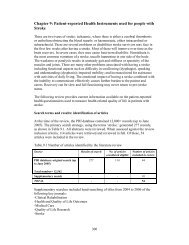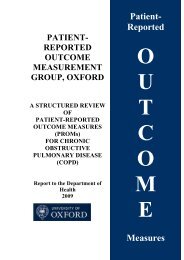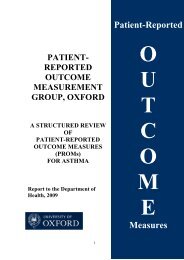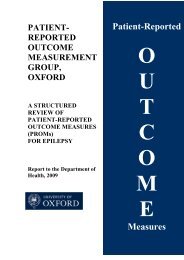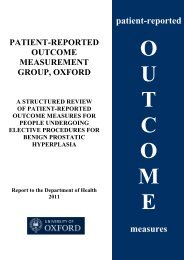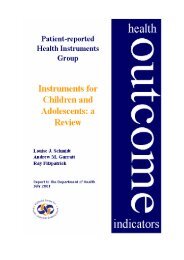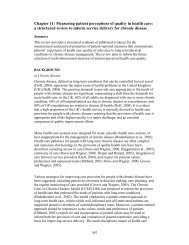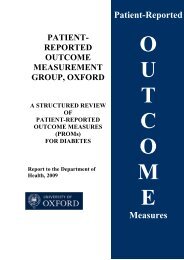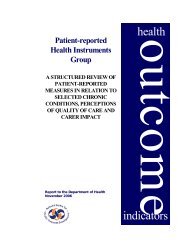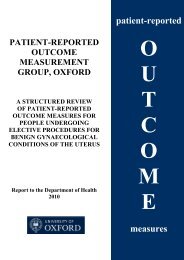2011 review - Patient-Reported Outcomes Measurement - University ...
2011 review - Patient-Reported Outcomes Measurement - University ...
2011 review - Patient-Reported Outcomes Measurement - University ...
Create successful ePaper yourself
Turn your PDF publications into a flip-book with our unique Google optimized e-Paper software.
patient-reported<br />
PATIENT-REPORTED<br />
OUTCOME MEASUREMENT<br />
GROUP, OXFORD<br />
O<br />
U<br />
A STRUCTURED REVIEW OF<br />
PATIENT-REPORTED OUTCOME<br />
MEASURES FOR PATIENTS<br />
UNDERGOING<br />
CHOLECYSTECTOMY<br />
T<br />
C<br />
O<br />
Report to the Department of Health, <strong>2011</strong><br />
M<br />
E<br />
measures
A STRUCTURED REVIEW OF PATIENT-REPORTED<br />
OUTCOME MEASURES FOR PATIENTS UNDERGOING<br />
CHOLECYSTECTOMY, <strong>2011</strong><br />
Carolina Casañas i Comabella<br />
Elizabeth Gibbons<br />
Ray Fitzpatrick<br />
<strong>Patient</strong>-reported Outcome <strong>Measurement</strong> Group<br />
Department of Public Health<br />
<strong>University</strong> of Oxford<br />
Copies of this report can be obtained from:<br />
Elizabeth Gibbons<br />
Senior Research Officer<br />
<strong>Patient</strong>-reported Outcome <strong>Measurement</strong> Group<br />
tel: +44 (0)1865 289397<br />
e-mail: Elizabeth.gibbons@dph.ox.ac.uk
A STRUCTURED REVIEW OF PATIENT-REPORTED OUTCOME<br />
MEASURES FOR PATIENTS UNDERGOING CHOLECYSTECTOMY<br />
CONTENTS:<br />
EXECUTIVE SUMMARY 1<br />
INTRODUCTION 3<br />
METHODS 5<br />
RESULTS: Generic <strong>Patient</strong>-reported Outcome Measures 8<br />
RESULTS: Preference-based <strong>Patient</strong>-reported Outcome Measures 11<br />
RESULTS: Condition-specific <strong>Patient</strong>-reported Outcome Measures 12<br />
CONCLUSIONS AND RECOMMENDATIONS 15<br />
Appendix A: Search strategy and sources 18<br />
Appendix B: Search Terms 19<br />
Appendix C: Appraisal criteria 20<br />
Appendix D: Generic & cholecystectomy-specific PROMs 23<br />
Appendix E: Methods of working, membership and conclusions of<br />
consensus panel 27<br />
References 32
EXECUTIVE SUMMARY<br />
Aim of the report<br />
The aim of this report is to identify <strong>Patient</strong>-reported Outcome Measures (PROMs)<br />
which have been evaluated with patients undergoing an elective cholecystectomy<br />
procedure.<br />
The methods of the <strong>review</strong> are described and the results of the searches including<br />
sources and search terms used to identify relevant published research. Details of this<br />
evidence are presented for generic health status measures, for preference-based<br />
measures and then for condition or procedure-specific PROMs. The <strong>review</strong> resulted<br />
in the identification of a short-list of PROMs which were presented to a<br />
multidisciplinary panel for comment. The <strong>review</strong> of the literature-based evidence and<br />
the comments of the multidisciplinary panel underpin final recommendations to the<br />
Department of Health.<br />
Results<br />
Two generic instruments, which have been evaluated with people undergoing<br />
cholecystectomy, were identified in this <strong>review</strong>:<br />
1. SF-36<br />
2. Nottingham Health Profile (NHP)<br />
One preference-based measure was identified:<br />
1. European Quality of Life Questionnaire (EQ-5D)<br />
Four condition-specific measures were identified in this <strong>review</strong>:<br />
1. Gastrointestinal Quality of Life Index (GIQLI)<br />
2. Abdominal Surgery Impact Scale (ASIS)<br />
3. Gallstone Impact Checklist (GIC)<br />
4. Otago Gallstones Condition-Specific Questionnaire (CSQ)<br />
Recommendations<br />
Based on the volume of evaluations and good measurement and operational<br />
characteristics, both the SF-36 and the NHP are highlighted as promising PROMs for<br />
the evaluation of the quality of NHS services.<br />
One preference-based measure was also identified: the EQ-5D. However promising<br />
this instrument has proved in other health conditions, the reader should note there is<br />
very limited evidence regarding patients undergoing cholecystectomy in Englishspeaking<br />
populations.<br />
There is very limited evidence available in English-speaking populations and none of<br />
the condition-specific instruments clearly stands out as having considerably more<br />
supportive evidence. However, based on appraisal of evidence by the PROM Group,<br />
and taking into account ratings and comments from the panel, the Otago Gallstones<br />
Condition-Specific Questionnaire is worthy of consideration above the other<br />
condition-specific measures.<br />
1
INTRODUCTION<br />
<strong>Patient</strong>-reported outcome measures (PROMs) offer enormous potential to improve the<br />
quality and results of health services. They provide validated evidence of health from<br />
the point of view of the user or patient. They may be used to assess levels of health<br />
and need in populations, and in users of services they can provide evidence of the<br />
outcomes of services for the purposes of audit, quality assurance and comparative<br />
performance evaluation. They may also improve the quality of interactions between<br />
health professionals and individual service users.<br />
Lord Darzi’s Interim Report on the future of the NHS recommends that patientreported<br />
outcome measures (PROMs) should have a greater role in the NHS (Darzi<br />
2007). The new Standard NHS Contract for Acute Services, introduced in April 2008,<br />
included a requirement to report from April 2009 on patient-reported outcome<br />
measures (PROMs) for patients undergoing Primary Unilateral Hip or Knee<br />
replacements, Groin Hernia surgery or Varicose Vein procedures. Furthermore, Lord<br />
Darzi’s report ‘High Quality Care for All’ (2008) outlines policy regarding payments<br />
to hospitals based on quality measures as well as volume. These measures include<br />
PROMs as a reflection of patients’ experiences and views. Guidance has now been<br />
issued regarding the routine collection of PROMs for the selected elective procedures<br />
(Department of Health, 2008) and since April 2009, the routine collection of PROMs<br />
for the selected elective procedures has been implemented and is ongoing.<br />
There are three broad categories of PROMs: generic health status, preference-based,<br />
and condition- or population-specific-measures. Generic instruments comprise items<br />
intended to be relevant to the widest range of patient conditions and the general<br />
population. Preference-based measures are also broad in content but additionally<br />
provide utilities or values regarding health (for use in, for example, cost-utility<br />
analyses of interventions). Condition-specific instruments are often more focused on a<br />
particular disease or health condition (for example, diabetes), a patient population (for<br />
example, older people), a specific problem or symptom (for example, pain), or a<br />
described function (for example, activities of daily living). For any given area of<br />
health, condition-specific instruments may have greater clinical appeal due to the<br />
inclusion of content specific to particular conditions, and the likelihood of increased<br />
responsiveness to interventions.<br />
It has been recommended that a combination of a generic or utility measure with a<br />
specific measure be used in the assessment of patient-reported health outcomes, on the<br />
grounds that the complementary content of the two types of measure, when combined,<br />
should assess a full range of aspects of health relevant to the particular population<br />
concerned. However, consensus is often lacking as to which instrument to use for<br />
specific purposes and contexts (Garratt et al., 2002). Structured <strong>review</strong>s of PROMs for<br />
specific health conditions or populations can provide guidance for selection. An<br />
evidence-based approach strengthens recommendations from these <strong>review</strong>s.<br />
Selection criteria have been defined for assessing the quality of existing PROMs<br />
(Streiner and Norman, 2003; McDowell, 2006; Fitzpatrick et al., 1998). These include<br />
measurement issues, such as reliability, validity, responsiveness and precision, as well<br />
as practical issues, such as acceptability and feasibility.<br />
3
Cholecystectomy<br />
Cholecystectomy is a common elective procedure carried out in the NHS across<br />
England and consists of the surgical removal of the gallbladder. The main reasons for<br />
this surgical procedure are:<br />
<br />
<br />
Cholelithiasis. This refers to the presence of gallstones in the gallbladder;<br />
however this condition can be asymptomatic and in this case it does not<br />
always require a cholecystectomy.<br />
Cholecystitis. When the gallbladder is inflamed or infected it becomes a<br />
painful condition that requires a cholecystectomy.<br />
These conditions are generally painful and directly affect the quality of life (QoL) of<br />
the individual. <strong>Patient</strong>s can experience symptoms differently, but most of the people<br />
suffering from gallstones who require elective cholecystectomy experience symptoms<br />
and limitations such as billiary colic, diet restrictions which impact greatly on daily<br />
activities, causing a reduction in Health Related Quality of Life (Chen et al., 2006).<br />
Gallstones are crystalline bodies allocated in the biliary tract (i.e. gallbladder).<br />
Gallstones are formed by accretion or concretion of normal or abnormal bile<br />
components and can be of two types: cholesterol gallstones and pigment gallstones.<br />
Gallstones consist one of the most common causes of morbidity in the Western world,<br />
with an estimated incidence of symptomatic cholecystolithiasis of up to 2.17 per<br />
thousand inhabitants (Keus et at., 2009; Legorreta, 1993; Steiner, 1994).<br />
There are three types of cholecystectomy procedures:<br />
<br />
<br />
<br />
Open cholecystectomy (OC) (incision of more than 8cm)<br />
Small-incision cholecystectomy (SIC) (incision of 8cm or less)<br />
Laparoscopic cholecystectomy (LC) (less than four small incisions)<br />
Cholecystectomy is a very common elective procedure. The Hospital Episode<br />
Statistics (HES) reported that 58355 cholecystectomy procedures 1 took place in<br />
England during the HES financial year 2007-2008. Of these, 22% were performed<br />
during an emergency admission, and 25% were day case cholecystectomies. The<br />
mean length of stay for cholecystectomy for patients over 69 years old, or patients<br />
who presented complications, was 4.9 days, whereas the mean stay for patients<br />
younger than 70 years old or without complications was 2.1 days.<br />
All methods of cholecystectomy affect the patient’s QoL both in the pre-operative and<br />
post-operative situation, and this needs to be assessed. PROMs can provide valuable<br />
information about the patients’ perspective of their health and experiences of services.<br />
1 Based on Health Resource Group (HRG) combining G13 (cholecystectomy >69 or with complication)<br />
and G14 (cholecystectomy
METHODS<br />
Structure of the report<br />
The methods of the <strong>review</strong> are described, including search strategies and search terms<br />
used to identify specific published research regarding PROMs for cholecystectomy<br />
operations. The report focuses on evidence and recommendations for PROMs.<br />
Evidence is presented for generic, preference based and those PROMs specific to<br />
people undergoing elective cholecystectomy.<br />
Methods for the <strong>review</strong><br />
Methods adopted were as described in previous <strong>review</strong>s performed by the PROM<br />
group, Oxford. Comprehensive searches were conducted; articles retrieved were<br />
assessed for relevance and evidence of measurement performance and operational<br />
characteristics abstracted for each PROM identified.<br />
a) Search sources and terms<br />
Several sources were searched to identify relevant articles.<br />
The primary source of evidence was the bibliographic database compiled by the<br />
PROM group in 2002 with funding from the Department of Health and hosted by the<br />
<strong>University</strong> of Oxford 2 . In 2005, it became the property of the NHS Information Centre<br />
for Health & Social Care. The PROM database comprises 30,350 records up to the<br />
end of 2006 (16,054 online up to December 2005) downloaded from several<br />
electronic databases using a comprehensive search strategy (available on request).<br />
These records had been assessed as eligible for inclusion in the bibliography and<br />
assigned keywords. These records were searched using the keywords ‘gallstone’, ‘gall<br />
bladder’, ‘gallbladder’ and ‘cholecystectomy’, and combinations of keywords<br />
(‘surgery’, ‘gastrointestinal’, ‘hepatology’), and by instrument identified during the<br />
<strong>review</strong>. The search strategy used in this <strong>review</strong> and the flowchart illustrating the<br />
search process are detailed in Appendix A and B, respectively.<br />
Supplementary searches included scanning the reference lists of key articles, checking<br />
instrument websites, where found, and drawing on other bibliographic resources.<br />
Hand searching of titles of key journals from May 2009 was conducted. The<br />
following journals were selected:<br />
<br />
<br />
<br />
<br />
<br />
<br />
Health and Quality of Life <strong>Outcomes</strong><br />
Quality of Life Research<br />
Surgical Endoscopy<br />
American Journal of Surgery<br />
British Journal of Surgery<br />
Surgery<br />
2 Available online at http://phi.uhce.ox.ac.uk<br />
5
The National Institute for Health Research: Health Technology Assessment<br />
Programme published research was also searched.<br />
In addition, PubMed records for the past three years (2007-2009) were searched using<br />
a comprehensive search developed by the PROM group and Outreach Librarian at the<br />
<strong>University</strong> of Oxford. See Appendix B for the detailed search strategy.<br />
b) Inclusion criteria<br />
Published articles were included if they provided evidence of measurement and/or<br />
practical properties of relevant PROMs (Fitzpatrick et al., 1998).<br />
Population<br />
<br />
<br />
<br />
<br />
<br />
<br />
<strong>Patient</strong>s undergoing any kind of open cholecystectomy (OC)<br />
<strong>Patient</strong>s undergoing any kind of small-incision cholecystectomy (SIC)<br />
<strong>Patient</strong>s undergoing any kind of laparoscopic cholecystectomy (LC)<br />
<strong>Patient</strong>s with cholelithiasis<br />
<strong>Patient</strong>s with cholecystitis<br />
English speaking populations<br />
Study design selection<br />
<br />
<br />
<br />
<br />
Studies where a principal PROM is being evaluated<br />
Studies evaluating several PROMs concurrently<br />
Trials or studies evaluating the effectiveness of interventions; where a PROM<br />
is used as an endpoint.<br />
Prospective studies measuring patient-reported outcomes where data is<br />
available for a PROM in terms of measurement performance or operational<br />
characteristics<br />
Specific inclusion criteria for generic, preference- and disease-specific<br />
instruments<br />
<br />
<br />
<br />
<br />
The instrument is patient-reported<br />
There is published evidence of measurement reliability, validity or<br />
responsiveness following completion in the specified patient population<br />
Evidence is available from English language publications, and instrument<br />
evaluations conducted in populations within UK, North America, or<br />
Australasia.<br />
The PROM ideally will be multi-dimensional. It is at the <strong>review</strong>er’s discretion<br />
to include instruments which are specific to a health condition but have a<br />
narrow focus, for example a specific dimension of health, such as, symptoms.<br />
Exclusion criteria<br />
<br />
<br />
Clinician-assessed instruments<br />
Studies evaluating the performance of non-patient reported measures of<br />
functioning or health status where a PROM is used as a comparator indicator<br />
6
c) Data extraction<br />
For all PROMs included in the <strong>review</strong>, evidence is reported for the following<br />
measurement criteria:<br />
- reliability<br />
- validity<br />
- responsiveness<br />
- precision<br />
Operational characteristics such as patient acceptability and feasibility of<br />
administration for staff are also reported.<br />
d) Assessment of methodological quality of PROMs<br />
Assessment and evaluation of the PROMs was performed by using the appraisal<br />
criteria described in Appendix C.<br />
Searches identified over 700 potentially relevant records after excluding the<br />
duplicates. When assessed against the <strong>review</strong> inclusion criteria, 14 articles were<br />
included in the <strong>review</strong> (Table 1).<br />
Table 1: Number of articles identified by the literature <strong>review</strong><br />
Source<br />
Results of search<br />
Number of articles<br />
included in <strong>review</strong><br />
PROM database: 30,350 43 5<br />
Pubmed (2007-2009) 671 1<br />
Hand searching - 8<br />
TOTAL - 14<br />
7
RESULTS<br />
A total of seven PROMs for patients undergoing cholecystectomy were identified in<br />
this <strong>review</strong>. Two generic measures were identified:<br />
1. SF-36<br />
2. Nottingham Health Profile (NHP)<br />
The European Quality of Life Questionnaire (EQ-5D) was the only utility measure<br />
found.<br />
Finally, four condition specific instruments were included:<br />
1. Gastrointestinal Quality of Life Index (GIQLI)<br />
2. Abdominal Surgery Impact Scale (ASIS)<br />
3. Gallstone Impact Checklist (GIC)<br />
4. Otago Gallstones Condition-Specific Questionnaire (CSQ)<br />
GENERIC MEASURES<br />
1) SF-36<br />
The SF-36 is a generic health status instrument which was developed during the 1970s<br />
deriving from the work of the Rand Corporation’s Medical <strong>Outcomes</strong> Study (MOS)<br />
(Ware, 2000). It contains 36 items covering 8 dimensions: Physical Functioning (PF:<br />
10 items), Role Limitations due to physical health problems (RP: 4 items), Bodily<br />
Pain (BP: 2), Social Functioning (SF: 2), General Mental Health (MH: 5), Role<br />
Limitations due to emotional problems (RE: 3), Vitality (V: 4) and General Health<br />
Perceptions (GH: 5). Two component scores are derived: Physical Component Score<br />
(PCS) and Mental Component Score (MCS). The questionnaire can be self-,<br />
interview- or telephone-administered, and it takes five to ten minutes to complete<br />
(McDowell, 2006).<br />
Five studies were identified which had used the SF-36 with people undergoing<br />
cholecystectomy in English-speaking populations. Two of these are UK-based studies<br />
(McMahon et al., 1994; Mallon et al., 2006).<br />
Discriminative validity was reported by Burney & Jones (2002) in a trial with 140<br />
patients undergoing either ambulatory or short-stay laparoscopic cholecystectomy.<br />
<strong>Patient</strong>s who were admitted for short-stay LC reported significantly poorer scores in<br />
PF (p = 0.005), RP (p = 0.039) and RE (p = 0.028) at two months. At six months,<br />
results were similar, with relative functional deficits persisting (Burney & Jones,<br />
2002).<br />
Velanovich (2000) carried out a study assessing various surgical procedures,<br />
including 30 patients who underwent cholecystectomy. Statistically significant<br />
improvements were noted between the median surgery preoperative scores and the<br />
postoperative laparoscopic scores in PF (85 vs. 95, p
sensitive detecting a significant difference between open and laparoscopic<br />
cholecystectomy in BP as would be expected following a more invasive procedure (70<br />
vs 41, p=0.05) (Velanovich, 2000).<br />
There were no statistically significant differences in any of the eight dimensions of the<br />
SF-36 between patients undergoing OC and LC in the period from 1998 to 2000<br />
(Mallon et al., 2006).<br />
The SF-36 was able to detect change in a study where McMahon et al. (1994)<br />
reported an improvement of PF (57 in LC vs. 43 in minilaparotomy; p
2) Nottingham Health Profile (NHP)<br />
The Nottingham Health Profile (NHP) was developed in the UK with the aim of<br />
assessing lay people’s perceptions about their health status (Hunt et al., 1986). It is a<br />
patient-reported outcome measure which is structured in two parts, which can be used<br />
separately. Part I consist of 38 items, each of them being a simple statement regarding<br />
subjective health status and with a yes/no answer option. It covers six dimensions:<br />
Physical Abilities (PA, 8 items), Pain (P= 8 items), Energy Levels (EL=3), Sleep<br />
(S=5), Emotional Reactions (ER=9) and Social Isolation (SI=5), and each dimension<br />
has a range of possible scores of 0 (no problems) to 100 (all items checked). Part II<br />
consists of seven items assessing different aspects of daily life with a yes/no answer<br />
option, and is less widely used because some items referring to work, holidays, etc,<br />
may not be applicable (McDowell, 2006).<br />
This questionnaire can be self-, interview-, or telephone-administered, and it takes<br />
around 10 minute to complete.<br />
This <strong>review</strong> identified five studies which used the NHP with people undergoing<br />
cholecystectomy in English speaking populations. Four of these studies were UKbased<br />
(Bardsley et al., 1992; Nicholl et al., 1992, 1994; Squirrell et al., 1998).<br />
The NHP detected significant changes pre and post cholecystectomy for EL, P, S and<br />
ER in 154 patients (Bardsley et al., 1992). NHP was also responsive to change in a<br />
group of 70 patients undergoing either LC or mini cholecystectomy one month after<br />
surgery and in the mini cholecystectomy group after 3 months (Barkun et al., 1992).<br />
The NHP was used by Squirrell et al. (1998) to assess QoL after LC and SC in 100<br />
patients. The questionnaire was completed at baseline (preoperatively), 3 weeks and 6<br />
months after operation. NHP was responsive to change in the Pain and Sleep scores<br />
(p
Of the 300 assessments in the Nicholl et al. (1994) study (6 assessments per each of<br />
the 50 participants), only 3 were missed. In a few cases patients also failed to answer<br />
all the questions at an assessment.<br />
No evidence was found on appropriateness, reliability, validity, precision,<br />
interpretability, acceptability or feasibility in English-speaking population studies<br />
regarding NHP in relation to cholecystectomy.<br />
PREFERENCE BASED MEASURES<br />
EQ-5D<br />
The European Quality of Life instrument (EuroQol), now generally known as the EQ-<br />
5D, was developed by researchers in five European countries as a measure with a core<br />
set of generic health status items, based on existing PROMs (The EuroQol Group,<br />
1990; Brazier et al., 1993). It was intended that, in application, the EQ-5D would be<br />
supplemented by disease-specific instruments. The developers recommend the EQ-5D<br />
for use in evaluative studies and policy research; it can also be used for economic<br />
evaluation. The measure can be self or interview-administered.<br />
There are two sections to the EuroQol: the five-dimension index and the EQ<br />
‘thermometer’. The EQ-5D assesses health across five domains, namely<br />
Anxiety/Depression (AD), Mobility (M), Pain/Discomfort (PD), Self-Care (SC), and<br />
Usual Activities (UA); each domain has one item and a three-point categorical<br />
response scale. Weights based upon societal valuations of health states are used to<br />
calculate an index score of –0.59 to 1.00, where –0.59 is a state worse than death and<br />
1.00 maximum well-being; a score profile can also be reported. The EQ thermometer<br />
is a single 20-cm vertical visual analogue scale with a range of 0 to 100, where 0 is<br />
the worst and 100 the best imaginable health.<br />
This <strong>review</strong> identified only one study using EQ-5D in relation to cholecystectomy in<br />
an English-speaking population. However the reader should note another UK-based<br />
study was identified which used EQ-5D in order to calculate QALYs after<br />
laparoscopic cholecystectomy (Macafee et al., 2009). The EQ-5D scores provided in<br />
this study show no statistically significant difference between early and delayed<br />
cholecystectomy in a total of 67 patients.<br />
Some limited evidence of responsiveness of the EQ-5D and VAS was reported in a<br />
study comparing quality of life outcomes between conventional laparoscopic<br />
cholecystectomy (CLC) and micropuncture laparoscopic cholecystectomy (MPLC) in<br />
40 patients in the United Kingdom (Ainslie et al., 2003). <strong>Measurement</strong>s were made<br />
preoperatively, then at 8h, 24h, one week and one month postoperatively. Change was<br />
observed within each group at 8 hours and 24 hours postoperatively with decrease in<br />
scores for EQ-5D and VAS, but this returned to baseline scores by one month. This<br />
would be in accordance with hypothesis as patients within 24 hours of surgery are<br />
likely to report worse health status.<br />
11
CONDITION-SPECIFIC MEASURES<br />
Four condition specific instruments were included:<br />
1. Gastrointestinal Quality of Life Index (GIQLI)<br />
2. Abdominal Surgery Impact Scale (ASIS)<br />
3. Gallstone Impact Checklist (GIC)<br />
4. Otago Gallstones Condition-Specific Questionnaire (CSQ)<br />
1) Gastrointestinal Quality of Life Index (GIQLI)<br />
The Gastrointestinal Quality of Life Index (GIQLI) is a Health-Related Quality of<br />
Life (HR-QoL) questionnaire which was developed in the early nineties and evaluated<br />
in German and Canadian populations (Barkun et al., 1992; Eypasch et al., 1993;<br />
Eypasch et al., 1995). It is a 36 item self-administered questionnaire aimed to evaluate<br />
QoL of patients with gastrointestinal disease, covering four dimensions: Physical,<br />
Emotional, Social and Symptoms. The developmental study of GIQLI (Eypasch et al.,<br />
1995), which was carried out in Germany, showed good validity, reliability and<br />
internal consistency. The GIQLI also showed good responsiveness: it detected<br />
statistically significant change before and after the operation, especially on the first<br />
postoperative measurement two weeks after surgery. However the reader should note<br />
these results are drawn from non-English speaking population. Despite not being a<br />
gallbladder-specific questionnaire, the GIQLI has been used to assess the QoL of<br />
patients undergoing cholecystectomy in one study.<br />
Furthermore, the GIQLI was developed simultaneously in German and English, and<br />
this <strong>review</strong> found only one study which used GIQLI to evaluate cholecystectomy in<br />
an English-speaking population.<br />
Responsiveness was reported in a clinical trial which evaluated QoL in 70 patients<br />
undergoing either laparoscopic cholecystectomy or mini cholecystectomy in Canada<br />
(Barkun et al., 1992). <strong>Measurement</strong>s were taken preoperatively, 1 month and 3<br />
months after cholecystectomy. The GIQLI was sensitive enough to detect significant<br />
improvement in both patient groups at one month after surgery (p>0.05).<br />
2) Abdominal Surgery Impact Scale (ASIS)<br />
The ASIS was recently developed in 2006 by Urbach et al. (2006) in Canada, with the<br />
aim of designing a measure of HRQoL specifically after abdominal surgery, for use as<br />
an outcome measure in studies comparing laparoscopic and conventional abdominal<br />
surgery. After item reduction, the final result was an 18-item questionnaire covering 6<br />
domains (Physical Limitations, Functional Impairment, Pain, Visceral Function,<br />
Sleep, Psychological Function).<br />
This <strong>review</strong> found only one study that used this PROM to evaluate cholecystectomy<br />
procedures. Urbach et al. (2006) administered the prototype to 500 patients<br />
undergoing both conventional and laparoscopic abdominal surgical procedures. Most<br />
of the laparoscopic operations were cholecystectomies (exact numbers not provided).<br />
12
The hypothesised factor structure of 6 domains was empirically confirmed by factor<br />
analysis in Urbach et al. (2006). However the authors admit that further research is<br />
also necessary to assess construct validity.<br />
The reliability coefficients were good for five of the scales, with Cronbach’s α<br />
ranging from 0.80 (Sleep) to 0.90 (Functional impairment) (Urbach et al., 2006).<br />
However, internal consistency of the Visceral function subscale was found to be low.<br />
The authors explain this by the fact that this scale was constructed from<br />
heterogeneous concepts such as gastrointestinal function, urinary function, cough, or<br />
thirst. However this does not mean that this scale would not be reliable according to<br />
other measures, for example test-retest reliability.<br />
3) Gallstone Impact Checklist (GIC)<br />
The Gallstone Impact Checklist (GIC) was developed in 1996 by Russell et al. in<br />
Canada. This is a disease-specific QoL questionnaire covering four dimensions: Pain,<br />
Dyspepsia, Emotional Impact and Food and Eating. It contains a 41-item checklist<br />
with a yes/no answer option, and, for each relevant item, a visual analogue scale in<br />
which to mark the extent to which the item was problematic. Perceived health was<br />
assessed using the question “Generally speaking, compared to other persons your age,<br />
would you rate your health as excellent, very good, good, fair or poor”. Finally,<br />
global perceptions of quality of physical and emotional well-being were measured on<br />
a 10-point ladder scale (0 representing the worst state and 10 representing the best).<br />
The questionnaire was designed to be self-administered and it takes around 10 to 15<br />
minutes to complete.<br />
Sixty-seven participants completed the baseline questionnaire in a trial by Russell et<br />
al. (1996), and 57 completed the follow-up. The questionnaire was administered at<br />
baseline (preoperatively) and four to six weeks later.<br />
Internal consistency was assessed using Cronbach’s α, which was overall 0.88 and<br />
found to be acceptable. For the Pain subscale, Cronbach’s α was 0.60; it was 0.73 for<br />
Dyspepsia; 0.78 for Emotional impact, and 0.84 for the Food and eating subscale.<br />
Temporal stability was assessed amongst the 9 individuals in this study who did not<br />
feel any improvement on their gallstone condition after the second completion of the<br />
questionnaire, showing good test-retest reliability. However, this is a small number<br />
which does not allow accurate assessment.<br />
The instrument proved to be responsive to change, with an absolute value of effect<br />
size of 1.63 in patients who had undergone surgery, in contrast to the 0.40 for those<br />
who had not (Russell et al., 1996).<br />
Chen et al. (2006) have pointed out some limitations of the GIC, arguing its<br />
lengthiness and complexity for use in routine settings.<br />
No further recent evaluations have been identified.<br />
13
4) Otago Gallstones Condition-Specific Questionnaire (CSQ)<br />
The Otago Gallstones Condition-Specific Questionnaire was developed by Chen et al.<br />
in 2006 in New Zealand, arising from concerns about the GIC (see above), such as<br />
feasibility and acceptability issues for use on routine settings (Chen et al., 2006). The<br />
authors devised a conceptual model for gallstone-specific QoL, with four underlying<br />
domains: Physical Functioning (pain, dyspepsia and diet changes), Systemic<br />
Functioning (fatigue), Social Functioning (daily duties, leisure, relationships) and<br />
Emotional Functioning (mood).<br />
The Otago gallstones condition-specific questionnaire (CSQ) contains 12 items, each<br />
with a 5-point Likert response scale. The final score is obtained using the simple<br />
summation method and converting it into a percentage score, where 100 is the most<br />
severe disease state. At the end of the questionnaire, a free text area is provided for<br />
the patient to add any concerns, comments or suggestions they felt were no captured<br />
by the structured <strong>review</strong>s (Chen et al., 2006).<br />
The questionnaire was administered to 54 patients (77 % women), alongside with the<br />
SF-36 as a generic QoL measure. This was followed by a semistructured interview<br />
with a researcher, seeking the patient’s opinion on the design, content and suitability<br />
of the CSQ. The Gallstone Impact Questionnaire (GIC) was administered as a<br />
reference for comparison.<br />
CSQ had good internal consistency, with Cronbach’s α = 0.94.<br />
Clinical relevance was also evaluated through the relationship of the scale to the<br />
surgeon-rated patient priority for surgery (CPAC) 4 , which showed a significant<br />
moderate correlation with average r = 0.62 (p
Comment<br />
The reader should note that this <strong>review</strong> also found a number of scales measuring pain:<br />
Visual Analogue Scale (VAS) and the McGill Pain Questionnaire. However, these<br />
two instruments were considered to be non-specific to either abdominal surgery or<br />
cholecystectomy and therefore no further comment is made.<br />
Cleary et al. (1991) used a generic self-report instrument that appears to be highly<br />
similar to the Functional Status Questionnaire (FSQ) to assess QoL in a sample of 476<br />
cholecystectomy patients, amongst other surgery patients. However this scale seemed<br />
to lack sensitivity to change in cholecystectomy patients (Cleary et al., 1991).<br />
SUMMARY OF EVIDENCE<br />
The full-text articles for 72 papers were retrieved and <strong>review</strong>ed. Those papers<br />
describing studies not used in English-speaking populations or symptom checklists or<br />
clinician ratings were excluded. Disappointingly, there were only 14 papers identified<br />
that provided useful data for this <strong>review</strong>.<br />
Two generic, one preference-based and four condition-specific PROMs were<br />
identified that had been evaluated with patients undergoing cholecystectomy, or<br />
suffering from gallstones, in English-speaking populations (Tables 2 and 3).<br />
The SF-36 (2 UK) and NHP (4 UK) both present good evidence in assessing general<br />
QoL in patients undergoing cholecystectomy in the UK. It should be noted that some<br />
studies have used modified versions of SF-36 adapted for this population.<br />
The EQ-5D has been evaluated in many different health conditions, however the<br />
evidence found in this <strong>review</strong> regarding cholecystectomy is very limited and<br />
extrapolating from the results of the study included may indicate a lack of<br />
responsiveness.<br />
This <strong>review</strong> identified four condition-specific instruments; however there is very<br />
limited evidence carried out in English-speaking populations firmly supporting any of<br />
them. Two of these instruments (GIQLI and ASIS) are region-specific: specific to<br />
gastro intestinal conditions and abdominal surgery. The other two (GIC and CSQ) are<br />
gallstone-specific.<br />
The GIQLI does present more evidence in relation to non-English speaking<br />
populations, but disappointingly, little for English-speaking, and its general focus<br />
limits its sensitivity for patients undergoing cholecystectomy procedures.<br />
15
RECOMMENDATIONS<br />
For the measurement of comprehensive general health status, the SF-36 has more<br />
psychometric supportive evidence and is acceptable to patients and can therefore be<br />
recommended.<br />
Despite very little encouraging evidence, the EQ-5D is widely used in the UK<br />
context and should be considered further for the assessment of general health in<br />
patients undergoing cholecystectomy.<br />
There is very limited evidence available in English-speaking populations and none of<br />
the condition-specific instruments clearly stands out as having considerably more<br />
supportive evidence. However, based on appraisal of evidence by the PROM Group,<br />
and taking into account ratings and comments from the panel, the Otago Gallstones<br />
Condition-Specific Questionnaire (CSQ) is worthy of consideration above the other<br />
condition-specific measures.<br />
16
Table 2: Appraisal of psychometric and operational performance of generic PROMs used in cholecystectomy.<br />
PROM<br />
(n of<br />
studies)<br />
SF-36<br />
(5)<br />
NHP<br />
(5)<br />
EQ-5D<br />
(1)<br />
Reproducibility Internal<br />
consistency<br />
Validity:<br />
Content<br />
Construct Responsiveness Interpretability Floor/ceiling/<br />
precision<br />
Acceptability Feasibility<br />
0 0 0 + ++ 0 0 + 0<br />
0 0 0 0 ++ 0 0 + 0<br />
0 N.A. 0 0 - 0 0 0 0<br />
0 not reported ― no evidence in favour + some limited evidence<br />
in favour<br />
++ some good<br />
evidence in favour<br />
++ + good evidence in favour.<br />
Table 3: Appraisal of psychometric and operational performance of cholecystectomy-specific PROMs.<br />
Instrument<br />
(n of<br />
studies)<br />
Reproducibility Internal<br />
consistency<br />
Validity:<br />
Content<br />
Construct Responsiveness Interpretability Precision<br />
Acceptability Feasibility<br />
GIQLI (1) 0 0 0 0 + 0 0 0 0<br />
ASIS (1) 0 + 0 + 0 0 0 0 0<br />
GIC (1) 0 + 0 + + 0 0 + 0<br />
CSQ (1) 0 + + + 0 0 + + +<br />
0 not reported ― no evidence in favour + some limited evidence<br />
in favour<br />
++ some good<br />
evidence in favour<br />
++ + good evidence in favour.<br />
17
APPENDIX A:<br />
SEARCH STRATEGY AND SOURCES<br />
SEARCH STRATEGY<br />
Bibliography<br />
5<br />
PubMed (from 2007)<br />
1<br />
Supplementary searches:<br />
8<br />
- Reference list of key articles<br />
- Instrument’s website (if available)<br />
- Hand search of key journals (last 6 months)<br />
- National Institute for Health Research: Health<br />
Technology Assessment Programme<br />
- Cochrane Library<br />
- OVID search<br />
TOTAL ARTICLES INCLUDED 14<br />
18
APPENDIX B:<br />
SEARCH TERMS USED IN PUBMED:<br />
Search ("2007"[Publication Date] : "3000"[Publication Date])<br />
AND<br />
(((cholelithiasis[tiab] OR cholecystitis[tiab] OR gallstone*[tiab] OR gall bladder[tiab]<br />
OR gallbladder[tiab] OR cholecystectomy[tiab])<br />
AND<br />
(HR-PRO[tiab] OR HRPRO[tiab] OR HRQL[tiab] OR HRQoL[tiab] OR QL[tiab] OR<br />
QoL[tiab] OR quality of life[tw] OR life quality[tw] OR health index*[tiab] OR<br />
health indices[tiab] OR health profile*[tiab] OR health status[tw] OR ((patient[tiab]<br />
OR self[tiab] OR child[tiab] OR parent[tiab] OR carer[tiab] OR proxy[tiab]) AND<br />
((report[tiab] OR reported[tiab] OR reporting[tiab]) OR (rated[tiab] OR rating[tiab]<br />
OR ratings[tiab]) OR based[tiab] OR (assessed[tiab] OR assessment[tiab] OR<br />
assessments[tiab]))) OR ((disability[tiab] OR function[tiab] OR functional[tiab] OR<br />
functions[tiab] OR subjective[tiab] OR utility[tiab] OR utilities[tiab] OR<br />
wellbeing[tiab] OR well being[tiab])<br />
AND<br />
(index[tiab] OR indices[tiab] OR instrument[tiab] OR instruments[tiab] OR<br />
measure[tiab] OR measures[tiab] OR questionnaire[tiab] OR questionnaires[tiab] OR<br />
profile[tiab] OR profiles[tiab] OR scale[tiab] OR scales[tiab] OR score[tiab] OR<br />
scores[tiab] OR status[tiab] OR survey[tiab] OR surveys[tiab]))))))<br />
Limits: English<br />
19
APPENDIX C:<br />
APPRAISAL OF THE METHODOLOGICAL QUALITY OF PROMs<br />
The methods that will be used for assessing the performance of PROMs were<br />
developed and tested against multi-disciplinary consensus and peer <strong>review</strong>. They<br />
focus on explicit criteria to assess reliability, validity, responsiveness, precision,<br />
acceptability and feasibility. A pragmatic combination of the criteria developed and<br />
used in previous reports to DH by the Oxford and LSHTM groups will be used.<br />
The appraisal framework focuses on psychometric criteria and PROMs must fulfil<br />
some or all to be considered as a short-listed instrument. Practical or operational<br />
characteristics are also assessed (acceptability and feasibility) (Appendix D: Appraisal<br />
framework).<br />
Psychometric and operational criteria<br />
0 not reported (no evaluation completed)<br />
- Evaluation evidence available indicating poor<br />
performance of instrument<br />
+ Some limited evidence in favour<br />
++ Good evidence in favour<br />
++ + Excellent evidence in favour<br />
20
Appraisal criteria (adapted from Smith et al., 2005 and Fitzpatrick et al., 1998; 2006):<br />
Appraisal<br />
component<br />
Reliability<br />
Reproducibility/Testretest<br />
reliability<br />
Internal consistency<br />
Validity<br />
Content validity<br />
Construct validity<br />
Definition/test<br />
The stability of a measuring instrument over time;<br />
assessed by administering the instrument to<br />
respondents on two different occasions and examining<br />
the correlation between test and re-test scores<br />
The extent to which items comprising a scale measure<br />
the same construct (e.g. homogeneity of items in a<br />
scale); assessed by Cronbach’s alpha’s and item-total<br />
correlations<br />
The extent to which the content of a scale is<br />
representative of the conceptual domain it is intended<br />
to cover; assessed qualitatively during the<br />
questionnaire development phase through pre-testing<br />
with patients. Expert opinion and literature <strong>review</strong><br />
Evidence that the scale is correlated with other<br />
measures of the same or similar constructs in the<br />
hypothesised direction; assessed on the basis of<br />
correlations between the measure and other similar<br />
measures<br />
Criteria for acceptability<br />
Test re-test reliability correlations for summary scores<br />
0.70 for group comparisons<br />
Cronbach’s alphas for summary scores ≥0.70 for group<br />
comparisons<br />
Item-total correlations ≥ 0.20<br />
Qualitative evidence from pre-testing with patients, expert<br />
opinion and literature <strong>review</strong> that items in the scale<br />
represent the construct being measured<br />
<strong>Patient</strong>s involved in the development stage and item<br />
generation<br />
High correlations between the scale and relevant<br />
constructs preferably based on a priori hypothesis with<br />
predicted strength of correlation<br />
21
Construct validity<br />
(continued)<br />
Responsiveness<br />
Floor/ceiling<br />
effects<br />
The ability of the scale to differentiate known-groups;<br />
assessed by comparing scores for sub-groups who are<br />
expected to differ on the construct being measured (e.g<br />
a clinical group and control group)<br />
The ability of a scale to detect significant change over<br />
time; assessed by comparing scores before and after an<br />
intervention of known efficacy (on the basis of various<br />
methods including t-tests, effect sizes (ES),<br />
standardised response means (SRM) or responsiveness<br />
statistics<br />
The ability of an instrument to measure accurately<br />
across full spectrum of a construct<br />
Statistically significant differences between known groups<br />
and/or a difference of expected magnitude<br />
Statistically significant changes on scores from pre to posttreatment<br />
and/or difference of expected magnitude. The<br />
recommended index of responsiveness is the effect size,<br />
calculated by subtracting the baseline score from the follow<br />
up score and dividing by the baseline SD. Effect sizes can<br />
be graded as small (0.8).<br />
Floor/ceiling effects for summary scores
APPENDIX D: GENERIC AND CONDITION-SPECIFIC INSTRUMENTS<br />
GENERIC INSTRUMENTS<br />
Generic patient-reported health instruments<br />
Instrument (no. items) Domains (no. items) Response options Score<br />
European Quality of<br />
Life instrument<br />
(EuroQol, EQ-5D)<br />
(5+1)<br />
Nottingham Health<br />
Profile (NHP) (38)<br />
SF-36: MOS 36-item<br />
Short Form Health<br />
Survey (36)<br />
Anxiety/depression (1)<br />
Mobility (1)<br />
Pain/discomfort (1)<br />
Self-care (1)<br />
Usual activities (1)<br />
EQ-thermometer: Global health (1)<br />
Bodily pain (BP) (8)<br />
Emotional reactions (ER) (9)<br />
Energy (E) (3)<br />
Physical mobility (PM) (8)<br />
Sleep (S) (5)<br />
Social isolation (SI) (5)<br />
Physical functioning (PF) (10)<br />
Role limitation-physical (RP) (4)<br />
Bodily pain (BP) (2)<br />
General health (GH) (5)<br />
Vitality (VT) (4)<br />
Social functioning (SF) (2)<br />
Role limitation-emotional (RE) (3)<br />
Mental health (MH) (5)<br />
Health transition (1)<br />
Categorical: 3 options<br />
EQ-thermometer<br />
VAS<br />
Recall: current health<br />
Yes/no; positive<br />
responses weighted<br />
Recall: ‘general’<br />
health<br />
Categorical: 2-6<br />
options<br />
Recall: standard 4<br />
weeks, acute 1 week<br />
Summation: domain profile<br />
Utility index (–0.59 to 1.00)<br />
EQ-Thermometer<br />
VAS (0-100)<br />
Algorithm<br />
Domain profile 0-100, 100 is<br />
maximum limitation<br />
Algorithm<br />
Domain profile (0-100, 100 best<br />
health)<br />
Summary: Physical (PCS), Mental<br />
(MCS) (mean 50, sd 10)<br />
Administration<br />
(completion<br />
time in<br />
minutes)<br />
Interview or self<br />
Interview<br />
Self (10-15)<br />
Interview (mean<br />
values 14-15)<br />
Self (mean 12.6)<br />
23
Summary of generic instruments: health status domains (after Fitzpatrick et al., 1998)<br />
Instrument<br />
(no. items)<br />
Physical<br />
function<br />
Symptoms<br />
Global judgement<br />
of health<br />
Instrument domains<br />
Psychological<br />
well-being<br />
Social<br />
well-being<br />
Cognitive<br />
functioning<br />
EQ-5D<br />
(5+1) X X X X X X<br />
NHP (38) X X X X<br />
SF-36 (36) X X X X X X<br />
Role<br />
activities<br />
Personal<br />
constructs<br />
24
CONDITION-SPECIFIC INSTRUMENTS<br />
Condition-specific patient-reported health instruments<br />
Instrument (no. items) Domains (no. items) Response options Score<br />
Gastrointestinal<br />
Quality of Life Index<br />
(GIQLI) (36)<br />
Four domains:<br />
Physical, Emotional, Social, Symptoms<br />
5-point Likert scale<br />
Recall: past 2 weeks<br />
0-144 (higher score represent better<br />
QoL)<br />
Administration<br />
(completion<br />
time in<br />
minutes)<br />
Self (completion<br />
time not stated)<br />
Abdominal Surgery<br />
Impact Scale (ASIS)<br />
(18)<br />
Gallstone Impact<br />
Checklist (GIC) (41)<br />
Otago Gallstones<br />
Condition-Specific<br />
Questionnaire (CSQ)<br />
(12)<br />
Six domains:<br />
Physical limitations (3)<br />
Functional impairment (3)<br />
Pain (3)<br />
Visceral function (3)<br />
Sleep (3)<br />
Psychological function (3)<br />
Four domains:<br />
Pain, Dyspepsia , Emotional impact, Food and eating<br />
Four domains:<br />
Physical functioning, Systemic functioning, Social<br />
functioning, Emotional functioning<br />
Not provided Not provided Self (completion<br />
time not stated)<br />
Check yes/no.<br />
Items applicable have<br />
Global well-being<br />
measured on 10-point<br />
ladder scale<br />
5-point Likert scale<br />
Free text area<br />
provided at end of<br />
questionnaire<br />
VAS (only in items checked ‘yes’)<br />
0-10, 10 is best health<br />
Summation converted into %<br />
(100% = most severe disease state)<br />
Self (10-15)<br />
Self (
Summary of condition-specific instruments: health status domains (after Fitzpatrick et al., 1998)<br />
Instrument<br />
(no. items)<br />
Instrument domains<br />
Physical<br />
function<br />
Symptoms Global judgement<br />
of health<br />
Psychological<br />
well-being<br />
Social<br />
well-being<br />
Cognitive<br />
functioning<br />
Role<br />
activities<br />
GIQLI X X X X<br />
ASIS X X X<br />
GIC X X X<br />
CSQ X X X X X<br />
Personal<br />
constructs<br />
26
APPENDIX E: Methods of working, membership and conclusions of consensus<br />
panel<br />
Members of the panel were invited to participate based on their clinical or research<br />
experience of cholecystectomy and special interest in <strong>Patient</strong>-reported Outcome<br />
Measures. Eight potential members were initially contacted, or which four agreed to<br />
participate: all of them were consultant surgeons with expertise in cholecystectomy in<br />
NHS hospitals.<br />
The panel were sent the following documents:<br />
<br />
<br />
A structured <strong>review</strong> of patient-reported outcome measures for people<br />
undergoing cholecystectomy: A report to the Department of Health.<br />
Copies of the PROMs short-listed for discussion.<br />
The panel were sent by email rating scales to judge the suitability of the questionnaire<br />
for use in the NHS for the evaluation of services. There was a section for comments.<br />
The rating scale used the following responses:<br />
‘not at all suitable’ (score 0);<br />
‘to some extent unsuitable’ (score 1);<br />
‘uncertain’ (score 2);<br />
‘to some extent suitable’ (score 3);<br />
‘very suitable’ (score 4).<br />
Scores for each questionnaire were ranked in order of preference. The Total maximum<br />
score=16.<br />
Ratings and comments<br />
Generic measures<br />
Overall there was agreement that, of the two generic measures proposed in this<br />
<strong>review</strong>, the SF-36 would be more appropriate to be used with people undergoing<br />
cholecystectomy. Its validity and appropriateness for general health issues was<br />
acknowledged. However in general it was considered that this questionnaire may not<br />
capture issues that are specific in this population, and it may need to be administered<br />
alongside another instrument that would be more specific. The recall period of 4<br />
weeks used by the SF-36 was not considered ideal for this condition, due to its acute<br />
intermittent symptoms, thus presenting a potential risk of inaccurate assessment.<br />
There seemed to be an agreement that the NHP has a smaller amount of evidence<br />
supporting its use with people undergoing cholecystectomy. In addition, its questions<br />
were considered too broad and may not capture specific issues.<br />
In general, it was felt that the generic measures may not be appropriate for the current<br />
laparoscopic techniques used in cholecystectomy (rather than the traditional open<br />
surgery approach, which may have long-term sequels that may be indeed<br />
27
appropriately captured by a broad general health questionnaire). It was suggested that<br />
they could be used in combination with another questionnaire that would capture the<br />
issues specific to the condition.<br />
The EQ-5D was the only utility measure identified in this <strong>review</strong>. The panel agreed<br />
that this is a broad instrument that may not capture cholecystectomy-specific aspects<br />
accurately, and also has a very small amount of evidence supporting its use in this<br />
population.<br />
Conclusions of scoring<br />
Generic<br />
instrument<br />
‘not at all<br />
suitable’<br />
(score 0)<br />
‘to some<br />
extent<br />
unsuitable’<br />
(score 1)<br />
‘uncertain’<br />
(score 2)<br />
28<br />
‘to some<br />
extent<br />
suitable’<br />
(score 3)<br />
‘very<br />
suitable’<br />
(score 4)<br />
Total score<br />
SF-36 1 6 4 11<br />
NHP 1 4 3 8<br />
EQ-5D 0 2 3 5<br />
The panel rated each questionnaire using the response categories listed above,<br />
favouring the SF-36. This is consistent with the comments, although all members<br />
pointed out that a generic instrument alone may not be sufficient to be used as a<br />
PROM in cholecystectomy. EQ-5D was the only utility measure identified in the<br />
<strong>review</strong>, and it was rated relatively low.<br />
Condition-specific measures<br />
The panel commented on four condition-specific instruments:<br />
- GIQLI<br />
- ASIS<br />
- GIC<br />
- CSQ<br />
It was agreed by the panel that the amount of evidence for the GIQLI in Englishspeaking<br />
populations may not be enough to recommend its routine use in the NHS. It<br />
was also highlighted that most of the questions in this instrument are too broad and do<br />
not cover gallbladder related symptoms.<br />
Most members of the panel felt that the ASIS would not be suitable to assess the<br />
effects of laparoscopic cholecystectomy. However one of the members felt it had<br />
good feasibility, as it was perceived to be easy to use and understand.<br />
The panel agreed with the conclusions of the report regarding the GIC, in terms of<br />
length and lack of validity testing. It was also thought to be unsuitable to discriminate<br />
between different methods of cholecystectomy.<br />
The members of the panel agreed that the CSQ could be the most suitable<br />
questionnaire of the condition-specific identified by the <strong>review</strong>, since it was felt it
captures specific issues. However, as expressed in the <strong>review</strong>, members of the panel<br />
noted the lack of evidence and felt that a pilot study would be advised prior to its<br />
routine use. A potential limitation of this instrument was mentioned regarding the<br />
functional aspects of recovery (“return to normal physical, social and employment<br />
function”), which are essential after laparoscopic cholecystectomy.<br />
Conclusions of scoring<br />
Condition-<br />
specific<br />
instruments<br />
‘not at all<br />
suitable’<br />
(score 0)<br />
‘to some<br />
extent<br />
unsuitable’<br />
(score 1)<br />
‘uncertain’<br />
(score 2)<br />
‘to some<br />
extent<br />
suitable’<br />
(score 3)<br />
‘very<br />
suitable’<br />
(score 4)<br />
Total score<br />
GIQLI 1 2 8 11<br />
ASIS 0 2 2 4<br />
GIC 1 2 3 4 10<br />
CSQ 6 8 14<br />
The panel rated each questionnaire using the response categories listed above. Four<br />
questionnaires were scored:<br />
- GIQLI<br />
- ASIS<br />
- GIC<br />
- CSQ<br />
Of all the condition-specific instruments identified in this <strong>review</strong>, the CSQ was the<br />
questionnaire believed to be the most appropriate by the panel to be used with people<br />
undergoing cholecystectomy, if a choice were to be made. However limitations were<br />
pointed out, such as the lack of evidence supporting its use. This issue is more or less<br />
common to all the questionnaires suggested.<br />
29
<strong>Patient</strong>-reported Outcome Measure Rating Scale<br />
1. On the basis of the <strong>review</strong> of evidence and your personal experience, is this questionnaire suitable for the measurement of the<br />
quality and outcomes of services for people undergoing cholecystectomy (please tick one box)<br />
□ Not at all suitable □ To some extent unsuitable □ Uncertain □ To some extent suitable □Very suitable<br />
Do you have another questionnaire you could suggest<br />
Any additional comments<br />
30
CHOLECYSTECTOMY OUTCOMES CONSENSUS GROUP MEMBERS<br />
Dr Stepehn Attwood<br />
Consultant Surgeon, Northumbria Healthcare Foundation Trust,<br />
Northumberland.<br />
Dr Avril Chang<br />
Consultant Surgeon, Institute of Minimal Access Surgery, King's College<br />
Hospital, London.<br />
Dr Liam Horgan<br />
Consultant Surgeon, Northumbria Healthcare Foundation Trust, Northumberland.<br />
Dr Zahir Soonawalla<br />
Consultant Surgeon, Nuffield Department of Surgery, Oxford.<br />
PROM Group<br />
Ray Fitzpatrick<br />
Professor of Public Health and Primary Care, Department of Public Health, <strong>University</strong><br />
of Oxford.<br />
Elizabeth Gibbons<br />
Senior Research Officer, Department of Public Health, <strong>University</strong> of Oxford.<br />
Carolina Casañas i Comabella<br />
Research Officer, Department of Public Health, <strong>University</strong> of Oxford.<br />
31
REFERENCES<br />
Ainslie, W. G., Catton, J. A., Davides, D., Dexter, S., Gibson, J., Larvin, M., et al.<br />
(2003). Micropuncture cholecystectomy vs conventional laparoscopic<br />
cholecystectomy: a randomized controlled trial. Surgical Endoscopy, 17(5), 766-772.<br />
Bardsley, M. J., Venables, C. W., Watson, J., Goodfellow, J., & Wright, P. D. (1992).<br />
Evidence for validity of a health status measure in assessing short term outcomes of<br />
cholecystectomy. Quality in Health Care, 1(1), 10-14.<br />
Barkun, J. S., Barkun, A. N., Sampalis, J. S., Fried, G., Taylor, B., Wexler, M. J., et<br />
al. (1992). Randomised controlled trial of laparoscopic versus mini cholecystectomy.<br />
The McGill Gallstone Treatment Group. Lancet, 340(8828), 1116-1119.<br />
Brazier, J., Jones, N., & Kind, P. (1993). Testing the Validity of the Euroqol and<br />
Comparing It with the SF-36 Health Survey Questionnaire. Quality of Life Research.<br />
2(3), 169-180.<br />
Burney, R., & Jones, K. (2002). Ambulatory and admitted laparoscopic<br />
cholecystectomy patients have comparable outcomes but different functional health<br />
status. Surgical Endoscopy, 16(6), 921-926.<br />
Chen, T. Y. T., Landmann, M. G., Potter, J. C., & van Rij, A. M. (2006).<br />
Questionnaire to aid priority and outcomes assessment in gallstone disease. ANZ<br />
Journal of Surgery, 76(7), 569-574.<br />
Cleary, P. D., Greenfield, S., & McNeil, B. J. (1991). Assessing quality of life after<br />
surgery. Controlled Clinical Trials, 12(4 Suppl), 189S-203S.<br />
Darzi A. (2007). Our NHS Our Future: NHS Next Stage Review Interim Report.<br />
London: Department of Health.<br />
Darzi A. (2008). Our NHS Our Future: High Quality Care for All. NHS Next Stage<br />
Review Final Report. London: Department of Health.<br />
Darzi, A., Geraghty, J. G., Williams, N. N., Sheehan, S. S., Tanner, A. N., & Keane,<br />
F. B. (1994). The pros and cons of laparoscopic cholecystectomy and extracorporeal<br />
shock wave lithotripsy in the management of gallstone disease. Annals of the Royal<br />
College of Surgeons of England, 76(1), 42-46.<br />
Department of Health (2008). Guidance on the routine collection of <strong>Patient</strong>-<strong>Reported</strong><br />
Outcome Measures (PROMs) for the NHS in England 2009/10. London: Department<br />
of Health.<br />
Eypasch, E., Williams, J. I., Wood-Dauphinee, S., Ure, B. M., Schmulling, C.,<br />
Neugebauer, E., et al. (1995). Gastrointestinal Quality of Life Index: Development,<br />
validation and application of a new instrument. British Journal of Surgery, 82(2), 216-<br />
222.<br />
32
Eypasch, E., ood-Dauphin e, S., Williams, J. I., Ure, B., Neugebauer, E., & Troidl,<br />
H. (1993). The Gastrointestinal Quality of Life Index. A clinical index for measuring<br />
patient status in gastroenterologic surgery. Der Chirurg,64(4), 264-74.<br />
Fitzpatrick, R., Davey, C., & Buxton, M. (1998). Evaluating patient-based outcome<br />
measures for use in clinical trials. Health technology assessment, vol. 2/no. 14. Alton<br />
(GB): Core Research.<br />
Garratt A, Schmidt L, Mackintosh A, Fitzpatrick R. (2002). Quality of life<br />
measurement: bibliographic study of patient assessed health outcome measures.<br />
British Medical Journal, 324:1417.<br />
Hospital Episode Statitistics HES, 2007-08. The Health and Social Care Information<br />
Centre (2009). Retrieved on October 2009 from<br />
http://www.hesonline.nhs.uk/Ease/servlet/ContentServersiteID=1937&categoryID=2<br />
06<br />
Hunt, S. M., McEwen, J., & McKenna, S. P. (1986). Measuring health status.<br />
London: Croom Helm.<br />
Jones, K. R., Burney, R. E., Peterson, M., & Christy, B. (1998). Measuring healthstatus<br />
improvement after surgery: experience with the SF-36. Seminars for Nurse<br />
Managers, 6(3), 139-143.<br />
Keus, F., Gooszen, H. G., & Van Laarhoven, C. J. H. M. (2009). Systematic <strong>review</strong>:<br />
open, small-incision or laparoscopic cholecystectomy for symptomatic<br />
cholecystolithiasis. Alimentary Pharmacology & Therapeutics, 29(4), 359-378.<br />
Legorreta, A. P., Silber, J. H., Costantino, G. N., Kobylinski, R. W., & Zatz, S. L.<br />
(1993). Increased cholecystectomy rate after the introduction of laparoscopic<br />
cholecystectomy. JAMA, 270(12), 1429-1432.<br />
Macafee, D. A. L., Humes, D. J., Bouliotis, G., Beckingham, I. J., Whynes, D. K., &<br />
Lobo, D. N. (2009). Prospective randomized trial using costutility analysis of early<br />
versus delayed laparoscopic cholecystectomy for acute gallbladder disease. British<br />
Journal of Surgery, 96, 1031-1040.<br />
Mallon, P., White, J., McMenamin, M., Das, N., Hughes, D., & Gilliland, R. (2006).<br />
Increased cholecystectomy rate in the laparoscopic era: a study of the potential<br />
causative factors. Surgical Endoscopy, 20(6), 883-886.<br />
McDowell, I. (2006). Measuring health A guide to rating scales and questionnaires.<br />
New York: Oxford <strong>University</strong> Press.<br />
McMahon, A., Russell, I., Baxter, J., Ross, S., Anderson, J., Morran, C., et al. (1994).<br />
Laparoscopic versus minilaparotomy cholecystectomy: a randomised trial. The<br />
Lancet, 343(8890), 135.<br />
33
Nicholl, J. P., Brazier, J. E., Milner, P. C., Westlake, C., Kohler, B., Williams, B. T.,<br />
et al. (1992). Randomised controlled trial of cost-effectiveness of lithotripsy and open<br />
cholecystectomy as treatments for gallbladder stones. The Lancet, 340(8823), 801-<br />
807.<br />
Nicholl, J. P., Ross, B., Milner, P. C., Brazier, J. E., Westlake, L., Kohler, B., et al.<br />
(1994). Cost effectiveness of adjuvant bile salt treatment in extracorporeal shock<br />
wave lithotripsy for the treatment of gall bladder stones. Gut, 35(9), 1294-1300.<br />
Paumgartner, G., & Sauter, G. H. (January 01, 2005). Extracorporeal shock wave<br />
lithotripsy of gallstones: 20th anniversary of the first treatment. European Journal of<br />
Gastroenterology & Hepatology, 17(5), 525-7.<br />
Russell, M. L., Preshaw, R. M., Brant, R. F., Bultz, B. D., & Page, S. A. (1996).<br />
Disease-specific quality of life: the Gallstone Impact Checklist. Clinical and<br />
Investigative Medicine. Médecine Clinique Et Experimentale, 19(6), 453-460.<br />
Squirrell, D. M., Majeed, A. W., Troy, G., Peacock, J. E., Nicholl, J. P., & Johnson,<br />
A. G. (1998). A randomized, prospective, blinded comparison of postoperative pain,<br />
metabolic response, and perceived health after laparoscopic and small incision<br />
cholecystectomy. Surgery, 123(5), 485-495.<br />
Steiner, C. A., Bass, E. B., Talamini, M. A., Pitt, H. A., & Steinberg, E. P. (1994).<br />
Surgical Rates and Operative Mortality for Open and Laparoscopic Cholecystectomy<br />
in Maryland. New Engand Journal of Medicine, 330(6), 403-408.<br />
Streiner, D. L., & Norman, G. R. (2003). Health measurement scales: A practical<br />
guide to their development and use. Oxford medical publications. Oxford: Oxford<br />
<strong>University</strong> Press.<br />
The EuroQol Group. EuroQol: a new facility for the measurement of health related<br />
quality of life. Health Policy 1990; 16, 199–208.<br />
Urbach, D., Harnish, J., McIlroy, J., & Streiner, D. (2006). A measure of quality of<br />
life after abdominal surgery. Quality of Life Research, 15(6), 1053-1061.<br />
Velanovich, V. (2000). Laparoscopic vs open surgery. Surgical Endoscopy, 14(1), 16-<br />
21.<br />
Ware, J. (2000). SF-36 health survey : manual and interpretation guide. Lincoln R.I.:<br />
QualityMetric Inc.<br />
34



